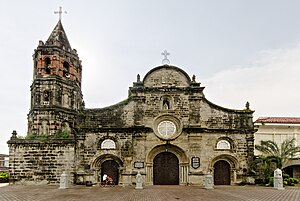Barasoain Church: Traces of History
Article by Ralph_D
They named the Barasoain Church during the Spanish-Filipino Revolution when it became a meeting place for anti-Spanish and anti-colonial illustrados. It is the parish of Our Lady of Mount Carmel. But it's more than just a typical Catholic church and parish; it represents or symbolizes faith, nationalism, history, and heroism.
History
The church has served as a venue for various events, including drafting the First Philippine Congress and the Malolos Institutions. In 1899, and the inauguration of two Philippine presidents, General Emilio Aguinaldo, the first President of the First Republic, and President Joseph Estrada, the thirteenth President of the Republic of the Philippines.
The capital of the Philippines was moved to Malolos, Bulacan, in 1898 during the reign of a revolutionary government. The Augustinian missionaries traveled via Calumpit to get to Barasoain from Pampanga. They observed a community that reminded them of the forest and the beauty of Barasoain in Navarra, Spain. [1]
The first Philippine Congress, also known as the Malolos Congress, headed by Don Pedro A. Paterno, was held at the Barasoain Church. As a result, the ratification of the Malolos Constitution in 1899 allowed for the establishment of the first Philippine republic. The church was dubbed the "Cradle of Democracy in the East."[2]
Church inaugurations have seen the swearing-in of only two Philippine presidents: General Emilio Aguinaldo, who led the revolutionary First Philippine Republic in 1899 (also known as the Malolos Republic), and former president Joseph Estrada, who took office in 1998, nearly a century later. Interestingly, neither President could complete their term: the first was held captive during the Philippine-American War, and the second was impeached during the EDSA People Power II Revolution, also known as EDSA Dos.
The Barasoain Museum houses historical and cultural treasures from the 1800s, and it is located next to the church in an interactive gallery. People preserve the aforementioned historical events in records and artifacts. The two most notable ones are a display of the Philippine Constitution and a glass engraving of the newspaper El Heraldo de la Revolution (Herald of the Revolution).
The convent of the Barasoain Church in Malolos is home to the Museum of the Republic of 1899 (Museo ng Republika ng 1899). Initially built in 1859 using nipa and bamboo, the church underwent two reconstructions. Today's visible structure was constructed in 1885 under Father Juan Giron, O.S.A.'s supervision, and is a prime example of Spanish colonial architecture.
Artist "AI PEREZ"
In 1968, he completed his degree in Fine Arts at the University of Santo Tomas. In 1984, he attended New York University's Art Students League and graduated from the Visual Arts School in 1996. He's realistically painting churches, houses, nipa huts, flowers, still lifes, and landscapes. The Philippine Post Office stamps were the inspiration for his paintings. In D.C., he hosted exhibits at the Philippine Trade Center. [3]
Painting
According to Mr.Perez, "My favorite will always be the historical Barasoain Church. It already has different versions because it has been restored many times because of fire," he also shared that he should personally see a church to paint it. That's his trick in giving each of his paintings its own story and personal. Heritage churches and other religious subjects are on exhibit until March 16 at the Museo ng Republika ng 1899 in Malolos, Bulacan, or the Barasoain Church Historical Landmark Museum.
References:
- Malolos Congress. (n.d.) https://www.barasoainchurch.org/about-us/malolos-congress?fbclid=IwAR2EmUJETUnW0eTLAOfLUPKBGC2GPjqqlBsFoJ0kVgHUuPJSxZxXuB0-CIo
- Banez, J. T.-. (n.d.). The historical Barasoain Church (built in 1630). Flickr. https://commons.wikimedia.org/wiki/File:Old_Barasoain.jpg
- Al Perez,(n.d.). Master Painter Of Heritage Churches, Featured In Exhibit At Barasoain Church Museum https://www.onenews.ph/articles/al-perez-master-painter-of-heritage-churches-featured-in-exhibit-at-barasoain-church-museum
External Links:
- Barasoain Church – “Cradle of Democracy in the East.” (n.d.). Vigattin Tourism (ARTICLES) - Philippines. https://www.vigattintourism.com/tourism/articles/Barasoain-Church-Cradle-of-Democracy-in-the-East
- ↑ https://www.barasoainchurch.org/about-us/malolos-congress?fbclid=IwAR2EmUJETUnW0eTLAOfLUPKBGC2GPjqqlBsFoJ0kVgHUuPJSxZxXuB0-CIo
- ↑ https://www.barasoainchurch.org/about-us/malolos-congress?fbclid=IwAR2EmUJETUnW0eTLAOfLUPKBGC2GPjqqlBsFoJ0kVgHUuPJSxZxXuB0-CIo
- ↑ https://www.onenews.ph/articles/al-perez-master-painter-of-heritage-churches-featured-in-exhibit-at-barasoain-church-museum
